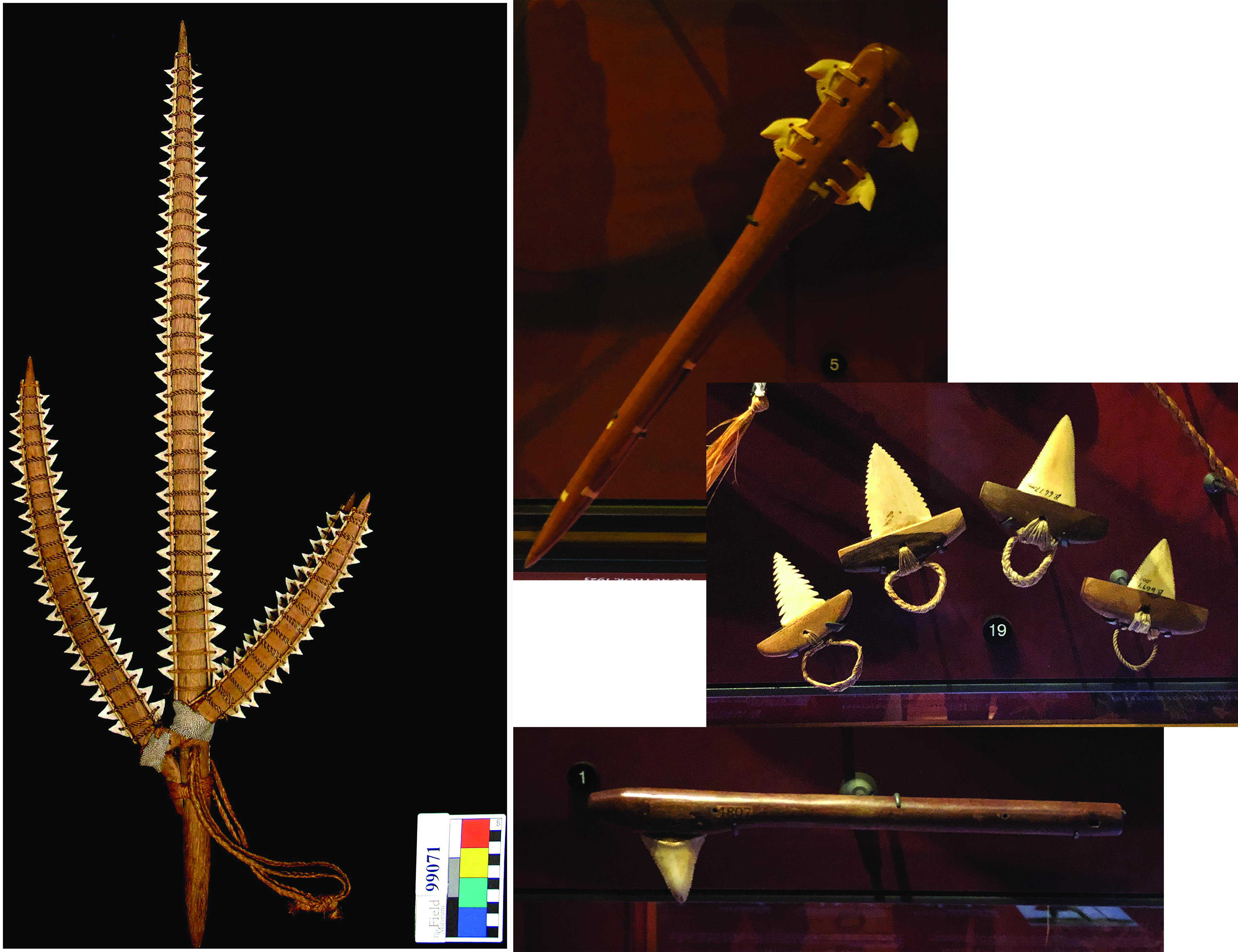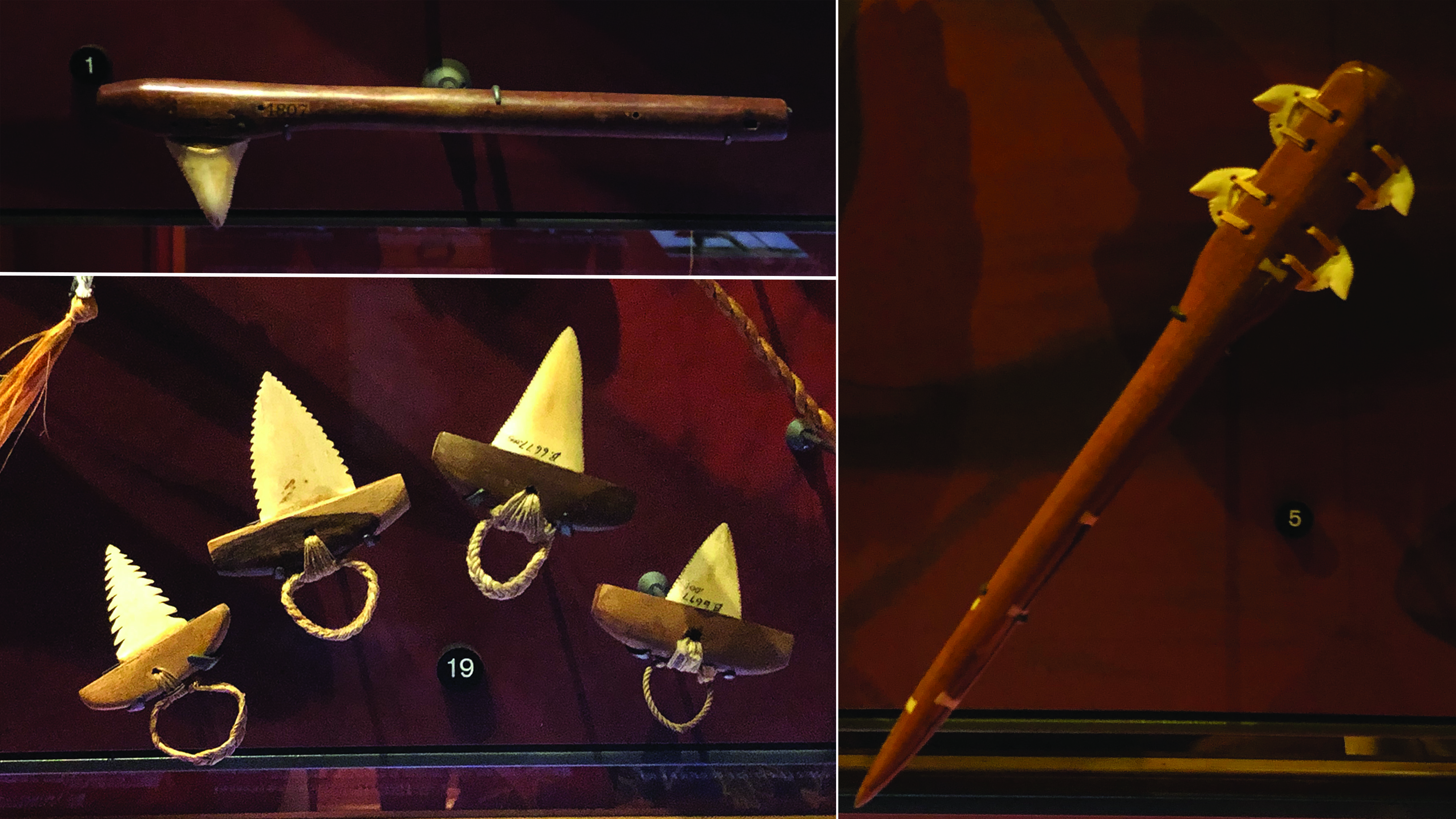Grade Level
6-12
minutes
1- 2 hrs
subject
Life Science
stem practices
Analyzing and Interpreting Data
Activity Type:
animal adaptations, ecology
 This resource is part of Science Friday’s Educator Phenomena Forum and was developed collaboratively by Randy Otaka, a K-12 educator, and Dr. Joshua Drew, who has used shark-toothed weapons from the Gilbert Islands to establish the presence of a species of shark in that area. Click here for a folder of classroom resources.
This resource is part of Science Friday’s Educator Phenomena Forum and was developed collaboratively by Randy Otaka, a K-12 educator, and Dr. Joshua Drew, who has used shark-toothed weapons from the Gilbert Islands to establish the presence of a species of shark in that area. Click here for a folder of classroom resources.
Let’s take a look at the shark-toothed weapons in the image below. On the left is an I-Kiribati shark-toothed weapon—I-Kiribati is a term that refers to the people of Kiribati, which includes the Gilbert Islands. On the right are three Hawaiian shark-toothed weapons, which were called leiomanō—or a Shark’s lei or wreath.

How are the Hawaiian artifacts similar to or different from those found in the Gilbert Islands? What do you notice and wonder about these weapons?
Keep track of your ideas on the Hawaiian Shark-Toothed Weapons Student Worksheet.
You may have noticed from these examples that both Gilbertese and some of the Hawaiian weapons attach shark teeth to their edges with string. If you look carefully, you may notice that Gilbertese weapons use shark teeth that are different from those used on the Hawaiian weapons. Why do you think they are different?

Let’s focus on the shark teeth that are used in the Hawaiian weapons. Use the Shark Tooth Identification Chart to try to identify the types of shark teeth in the Hawaiian weapons. What kinds of shark teeth do you see in the Hawaiian weapons?

You may have noticed that two of the weapons feature the angled teeth of a tiger shark, while one of the weapons has the large, triangular tooth of a great white shark.
Why did the Hawaiian people use those specific kinds of shark teeth in their weapons? We’re going to investigate this question from a few different angles and try to come up with an explanation. This may help us to understand why people in a specific region use the natural resources around them in a specific way.
First, let’s take a moment to come up with an explanation ourselves. Why do you think Hawaiian people used tiger shark teeth and great white shark teeth in their weapons? Write an initial explanation on your worksheet.
Activity One: Where Can We Find Hawaiian Sharks?
Let’s look at some sharks that are known to frequent Hawaii’s waters and their distribution ranges. As you move through these maps, write your answers on your Hawaiian Shark-Toothed Weapons Student Worksheet. If you were living in Hawaii, which sharks would you most likely encounter, and why?
Compare these ranges to average oceanic temperature and oceanic depth. What conclusions can you draw about certain species of sharks, based on their distribution ranges?


Reflection Questions
- Look at these close-up temperature and depth maps of the Hawaiian islands below. Keeping in mind the data you just reviewed and how you categorized your sharks, try to posit which sharks would most likely be found near those islands. Write your answers on your worksheet.
- Based on what you have learned, revise your explanation of why Hawaiians used particular shark teeth in their weapons.
Activity Two: What Are The Shapes Of Different Shark Teeth?
Now, let’s take another look at the shape of the teeth of different sharks. For each of the following sharks, try to describe to a partner or on paper the shape of the teeth, both on the upper jaw and the lower jaw. Try to guess what each shark tooth would be best at doing: hooking, stabbing, or cutting. Write your observations and possible explanations on the worksheet.
Materials
File folder, cereal box, or other oaktag/cardboard of similar thickness
Pen
Glue Stick
Scissors
Tissue Paper (about 12-24 sheets)
Activity Protocol
Reflection Questions
- Based on the data you collected (ease of stabbing/cutting and cleanness of stabbing/cutting), rank which shark teeth would be best for: a) a stabbing weapon; and b) a cutting weapon. Be sure to note how you made comparisons between different teeth.
- As a class, go through the slideshow below. With each shark, share your insights about the shapes of the shark teeth, and what you think each would be best at doing: stabbing or cutting.
- Keeping in mind what you have learned, try to further revise your explanation of why Hawaiians used particular shark teeth in their weapons.
Activity Three: What Are The Hawaiian Cultural Beliefs About Sharks?
At the time these weapons were made, Hawaiians called most sharks mano. Only the tiger shark and great white shark were called niuhi (“maneater”) because they were more dangerous than other sharks.
Let’s listen to Kapalikūokalani Maile, Education Programs Manager at the Bishop Museum in Honolulu, Hawaii, speak about the ways that Hawaiians understood and related to sharks in these short videos. Some of the videos have supplemental information that appears directly after the, which you can find linked below. View each video, the slideshow (if there is one), and answer the corresponding questions on your worksheet. Then, develop a final revised explanation for the use of those particular shark teeth in Hawaiian weapons.
So What Is Going On?
There are many reasons why Hawaiians used the teeth of tiger sharks and great white sharks for their weapons. First, based on the geographical distribution of these sharks and their preferences for warmer, shallower waters, Hawaiians would encounter these species of shark with greater frequency than others. Second, Hawaiians chose to use the teeth of specific species because of their shape and related function. Finally, Hawaiians chose the teeth of certain sharks because of their complex cultural beliefs relating to those sharks.
 This resource is part of Science Friday’s Educator Phenomena Forum and was developed collaboratively by Randy Otaka, a K-12 educator, and Dr. Joshua Drew, who has used shark-toothed weapons from the Gilbert Islands to establish the presence of a species of shark in that area. Click here for a folder of classroom resources.
This resource is part of Science Friday’s Educator Phenomena Forum and was developed collaboratively by Randy Otaka, a K-12 educator, and Dr. Joshua Drew, who has used shark-toothed weapons from the Gilbert Islands to establish the presence of a species of shark in that area. Click here for a folder of classroom resources.
Extensions
In this lesson, we looked at the geographical distribution of different shark species. But what if you could track the movements of individual sharks over time? There are several shark tracking projects that allow you to do this. Click here to track individual sharks (and other animals) around the world. Click here to track individual tiger sharks in the waters around Hawaii.
If you would like to learn more about Hawaiian cultural references to sharks, here are a few links that you can explore:
- The Swimming Trails of Pu‘uloa are the Trails Traveled by Ka‘ahupāhau
- A History of Fishing Practices and Marine Fisheries of the Hawaiian Islands (Ka hana lawaiʻa a me nā koʻa o na kai ʻewalu)
- Describing the Manifestations of Gods and their Associations with Aquatic Resources
- Description of Partaking of the Body of the Niuhi
- Shark-Catching
- Shark Fishing – Mano
- Shark Forms
Next Generation Science Standards
This resource works toward the following performance expectations:
- MS-LS2-4: Construct an argument supported by empirical evidence that changes to physical or biological components of an ecosystem affect populations.
- MS-LS2-2: Construct an explanation that predicts patterns of interactions among organisms across multiple ecosystems.
- HS-LS2-2: Use mathematical representations to support and revise explanations based on evidence about factors affecting biodiversity and populations in ecosystems of different scales.
Credits:
Special thanks to Kapalikūokalani Kalani Maile, Education Programs Manager at the Bishop Museum in Honolulu, Hawaii, for his invaluable guidance and wisdom (particularly in Part Three of the activity).
Written by Randy Otaka
Edits by Abigail Holstein and Xochitl Garcia
Advice and Review by Joshua Drew
Digital Production by Xochitl Garcia
 A selection of Science Friday’s podcasts, teaching guides, and other resources are available in the LabXchange library, a free global science classroom open to every curious mind.
A selection of Science Friday’s podcasts, teaching guides, and other resources are available in the LabXchange library, a free global science classroom open to every curious mind.
Meet the Writers
About Randy Otaka
Randy Otaka is an elementary school special education teacher and robotics coach for Wahiawa Elementary School in Wahiawa, Hawaii. He has a passion for STEM education and implements interactive and engaging lessons, such as using Minecraft to model the cardiovascular system to creating scale model solar system orbital paths.
About Joshua Drew
Joshua Drew is an assistant professor at SUNY College of Environmental Science and Forestry, and a fellow of the Royal Geographical Society. Originally from upstate NY, he has spent almost 15 years working on aquatic conservation issues from the Arctic to the Tropical Pacific. His students are exploring similar themes within and beyond New York’s waterways, with current projects in the Oswego River watershed and throughout Fiji.


